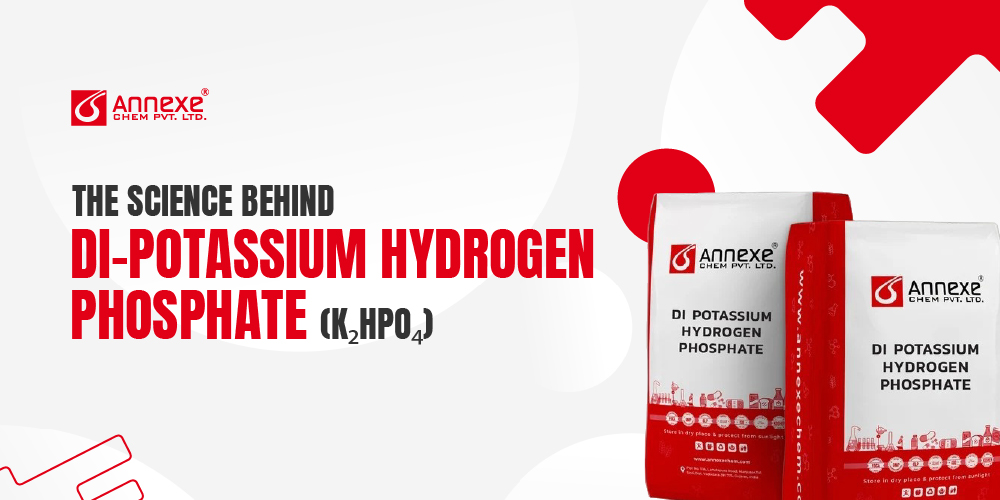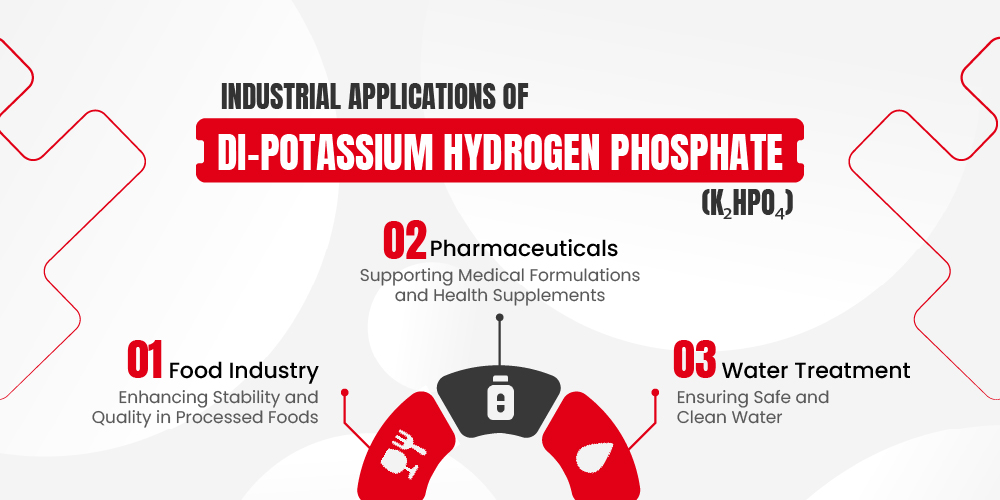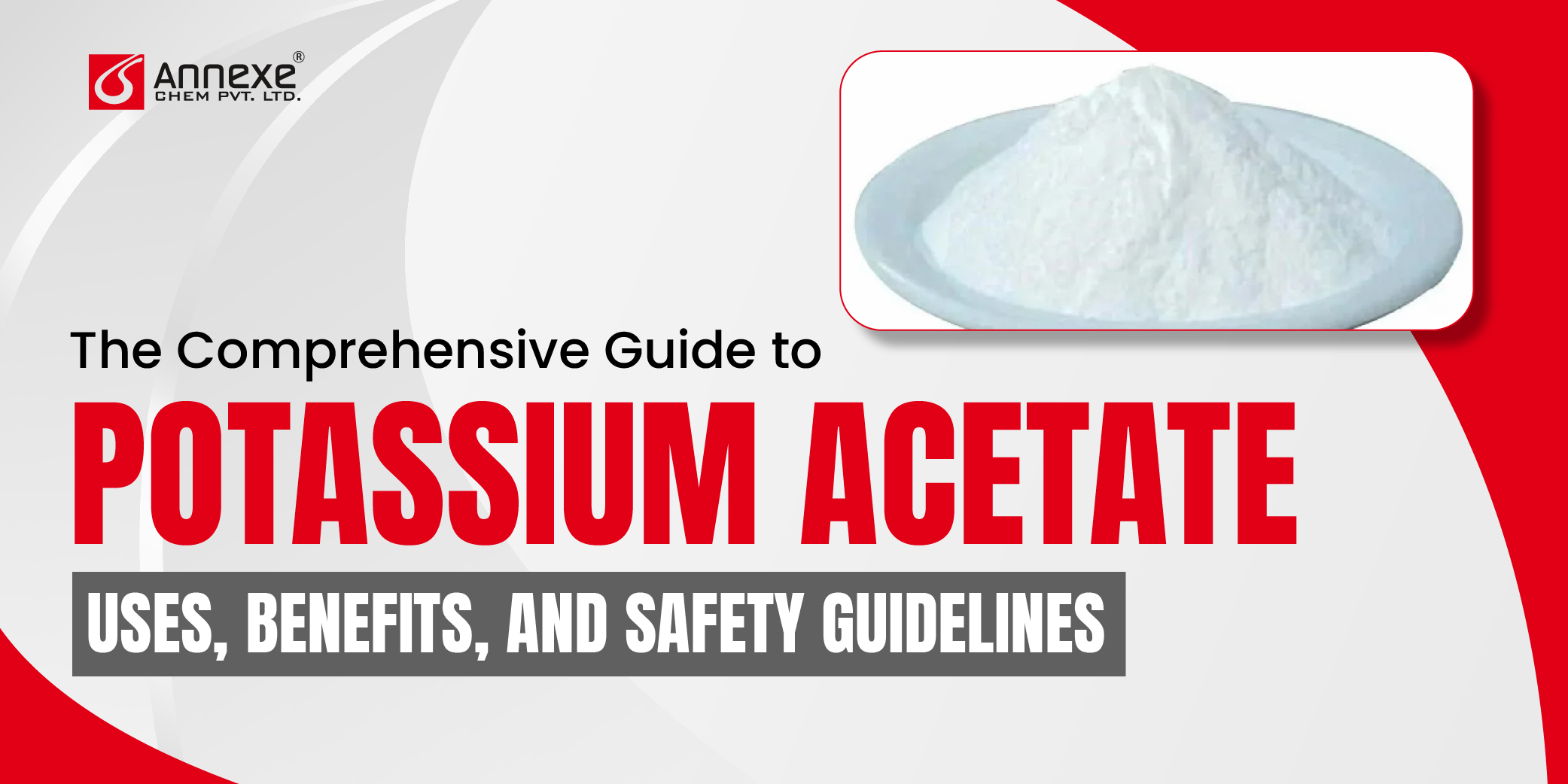Uses of Di-Potassium Hydrogen Phosphate (K₂HPO₄)
The Science Behind Di-Potassium Hydrogen Phosphate (K₂HPO₄): Benefits & Applications

- March 25, 2025
- By Akshita Patel
Ever wondered what keeps your favorite processed foods fresh, enhances crop growth, and plays a vital role in medical formulations? The answer lies in Di-Potassium Hydrogen Phosphate (K₂HPO₄)—a versatile compound with widespread industry applications. From acting as a pH regulator and emulsifier in the food industry to serving as a crucial ingredient in fertilizers and pharmaceuticals, this inorganic phosphate salt is more than just a chemical formula.
With its high solubility, buffering capabilities, and essential potassium and phosphorus content, K₂HPO₄ has become indispensable in agriculture, water treatment, and dietary supplements. But what makes it so special? How is it produced, and what are its key benefits and safety considerations? Let’s dive into the fascinating world of Di-Potassium Hydrogen Phosphate and explore its role in shaping multiple industries.
Introduction to Di-Potassium Hydrogen Phosphate
Di-Potassium Hydrogen Phosphate (K₂HPO₄) is an inorganic phosphate salt widely used across industries, including food, pharmaceuticals, agriculture, and water treatment. It is primarily valued for its role as a pH regulator, buffering agent, and potassium-phosphorus source. Due to its high solubility and stability, K₂HPO₄ is commonly incorporated into fertilizers, processed foods, and medical formulations.
Chemical Formula & Structure of Di-Potassium Hydrogen Phosphate
The chemical formula of Di-Potassium Hydrogen Phosphate is K₂HPO₄, representing two potassium (K⁺) ions, one hydrogen phosphate (HPO₄²⁻) ion, and an oxygen-phosphorus bond that stabilizes the compound. This structure enables strong buffering capabilities, making it useful in controlling pH levels in various applications.
Physical Properties of Di-Potassium Hydrogen Phosphate
- Solubility: Highly water-soluble, making it easy to dissolve in aqueous solutions.
- pH Level: Typically ranges from 8.7 to 9.4 in a 1% solution, making it mildly alkaline.
- Appearance: Usually found in white, odorless crystalline powder or granules.
- Stability: Non-volatile and stable under normal storage conditions, though it should be kept dry to prevent moisture absorption.
Comparison of Di-Potassium Hydrogen Phosphate with Other Phosphate Compounds
Di-Potassium Hydrogen Phosphate is one of several potassium phosphate compounds, each with unique properties and applications:
- Mono-Potassium Phosphate (KH₂PO₄): Contains only one potassium ion and is more acidic, with a lower pH, making it ideal for applications requiring a more acidic phosphate source, such as fertilizers and food additives.
- Tri-Potassium Phosphate (K₃PO₄): Contains three potassium ions, making it highly alkaline with a much higher pH, often used in industrial cleaners and heavy-duty detergents.
- Di-Potassium Hydrogen Phosphate (K₂HPO₄): Serves as a balanced buffering agent with moderate alkalinity, making it the preferred choice for pharmaceutical, food processing, and agricultural applications.
With its unique combination of solubility, pH balance, and buffering properties, K₂HPO₄ continues to be a versatile and essential compound in multiple industries.

Industrial Applications of Di-Potassium Hydrogen Phosphate (K₂HPO₄)
Di-Potassium Hydrogen Phosphate is a highly versatile and widely used inorganic phosphate salt, valued for its buffering, stabilizing, and pH-regulating properties. Its solubility and chemical stability make it an essential ingredient in multiple industries, including food processing, pharmaceuticals, and water treatment. Let’s explore how K₂HPO₄ contributes to each sector.
1. Food Industry: Enhancing Stability and Quality in Processed Foods
The food industry relies on Di-Potassium Hydrogen Phosphate for its ability to regulate acidity, stabilize emulsions, retain moisture, and extend shelf life. It is commonly used in processed foods, dairy products, beverages, and baked goods to maintain texture, taste, and consistency.
- pH Regulation: Maintaining the right pH is crucial for food stability and safety. K₂HPO₄ acts as a pH buffer, preventing excessive acidity or alkalinity in foods such as processed meats, dairy products, and beverages. A balanced pH enhances flavor, texture, and microbial stability.
- Emulsification in Dairy Products: K₂HPO₄ is commonly used in processed cheese, milk-based desserts, and creamers to prevent the separation of fats and proteins. This ensures a smooth, creamy texture and improves the melting properties of cheese.
- Moisture Retention in Baked Goods and Meat Products: By binding water molecules, K₂HPO₄ helps retain moisture in bread, cakes, and pastries, preventing them from drying out too quickly. In processed meats, it enhances juiciness and tenderness, improving overall texture.
- Preservative Function: The compound inhibits microbial growth and oxidation, helping extend the shelf life of ready-to-eat foods, frozen meals, and canned products. This is particularly useful in preventing spoilage in perishable food items.
- Nutrient Fortification: As a source of potassium and phosphorus, K₂HPO₄ is sometimes used to fortify foods and beverages, providing essential minerals for bone health, muscle function, and cellular energy production.
Common Food Products Containing K₂HPO₄:
- Processed cheese and dairy creamers
- Instant puddings and custards
- Meat and poultry products
- Carbonated soft drinks and energy drinks
- Baking powders and leavening agents
2. Pharmaceuticals: Supporting Medical Formulations and Health Supplements
In the pharmaceutical industry, Di-Potassium Hydrogen Phosphate plays a critical role in electrolyte balance, pH regulation, and medication stability. It is commonly used in intravenous (IV) solutions, dietary supplements, and oral medications.
- Electrolyte Balance in IV Fluids: K₂HPO₄ is an essential component of intravenous (IV) solutions, especially in patients with hypophosphatemia (low phosphate levels) or potassium deficiencies. It helps regulate fluid balance, muscle contractions, and nerve function in hospitalized patients.
- Buffering Agent in Medications: Many oral and injectable medications require a stable pH to ensure proper absorption and effectiveness. K₂HPO₄ acts as a buffering agent in antacids, pain relievers, and syrups, preventing changes in pH that could affect the drug’s performance.
- Dietary Supplements for Bone and Muscle Health: As a source of phosphorus and potassium, K₂HPO₄ is used in multivitamin and mineral supplements. Phosphorus is crucial for bone strength and energy production, while potassium supports heart health and muscle function.
- Pharmaceutical Excipient: K₂HPO₄ serves as an excipient (inactive ingredient) in tablets and capsules, helping to bind active ingredients, improve solubility, and enhance drug stability.
Common Pharmaceutical Applications:
- IV electrolyte solutions
- Oral rehydration salts (ORS)
- Dietary supplements
- Antacids and pH-regulating medications
- Prescription and over-the-counter syrups
3. Water Treatment: Ensuring Safe and Clean Water
Water treatment facilities use Di-Potassium Hydrogen Phosphate to help manage water quality, control pH levels, prevent corrosion, and support nutrient balance in drinking water, wastewater, and industrial water systems.
- pH Stabilization: K₂HPO₄ acts as a pH buffer, preventing sudden changes in water acidity or alkalinity. This helps maintain optimal water conditions for human consumption and industrial use.
- Corrosion Control in Pipelines: When water has an unstable pH, it can cause corrosion in metal pipes, leading to rust, leaks, and contamination. K₂HPO₄ helps prevent pipe corrosion in municipal water systems, reducing maintenance costs and improving water safety.
- Algae Growth Control in Wastewater Treatment: Excess phosphates in water can trigger algae blooms, disrupting aquatic ecosystems. Controlled use of K₂HPO₄ in wastewater treatment plants ensures phosphorus levels remain within safe limits, preventing environmental damage.
- Nutrient Supplementation in Aquatic Systems: In aquaculture and hydroponic farming, K₂HPO₄ is used to supply essential phosphorus and potassium, promoting healthy plant growth and fish development in controlled aquatic environments.
Common Applications in Water Treatment:
- Municipal water treatment plants
- Industrial cooling and boiler systems
- Aquaculture and hydroponic nutrient solutions
- Wastewater treatment facilities
Di-Potassium Hydrogen Phosphate is an indispensable compound across multiple industries, thanks to its pH-regulating, stabilizing, and nutrient-supplying properties. In the food industry, it ensures product stability, enhances texture, and improves shelf life. In pharmaceuticals, it plays a crucial role in medications, IV fluids, and dietary supplements. In water treatment, it helps maintain safe drinking water, prevents corrosion, and supports wastewater management.
With expanding industrial applications and a growing emphasis on food safety, medical advancements, and clean water solutions, the demand for K₂HPO₄ continues to rise. However, responsible use and compliance with safety regulations are essential to maximize its benefits while minimizing environmental impact.
Health & Safety Aspects of Di-Potassium Hydrogen Phosphate (K₂HPO₄)
While Di-Potassium Hydrogen Phosphate is widely used in food, pharmaceuticals, and water treatment, its impact on human health and environmental safety depends on its proper use and regulation. Understanding both the benefits and potential risks can help ensure responsible consumption and handling.
1. Health Benefits of K₂HPO₄:
K₂HPO₄ serves as an essential source of potassium and phosphorus, both of which play crucial roles in various bodily functions.
Electrolyte Balance and Muscle Function
- Potassium is a key electrolyte that helps regulate fluid balance, nerve signals, and muscle contractions.
- Adequate potassium levels prevent muscle cramps, irregular heartbeats, and fatigue.
- K₂HPO₄ is used in intravenous (IV) solutions and electrolyte supplements to correct potassium deficiencies.
Bone Health and Cellular Function
- Phosphorus is a vital component of bones and teeth, working alongside calcium and vitamin D to maintain bone density.
- It is essential for cellular energy production (ATP), ensuring proper metabolism and organ function.
- Found in dietary supplements and fortified foods, K₂HPO₄ helps meet daily phosphorus requirements.
pH Regulation and Metabolic Support
- Acts as a pH buffer in the body, preventing excessive acidity or alkalinity.
- Supports kidney function, helping remove excess acids and toxins from the bloodstream.
- Used in medical treatments for renal disorders and metabolic imbalances.
2. Potential Risks of Overconsumption & Environmental Concerns:
While K₂HPO₄ is generally recognized as safe (GRAS) when used appropriately, excessive intake or improper disposal can lead to health and environmental issues.
Overconsumption Risks
- Hyperkalemia (High Potassium Levels): Causes irregular heartbeats, muscle weakness, and potential cardiac arrest.
- Hyperphosphatemia (High Phosphorus Levels): This can result in kidney damage, calcification of soft tissues, and bone loss.
- People with kidney disease or heart conditions or are on potassium-sparing medications should consult a doctor before consuming phosphate supplements.
Environmental Concerns
- Excess Phosphates in Water Sources: Improper disposal of phosphate compounds, including K₂HPO₄, can contribute to water pollution and algal blooms in lakes and rivers.
- Soil Imbalance: Overuse in fertilizers may alter soil pH and affect crop growth.
- Regulatory Compliance: Many governments impose strict phosphate usage limits in food and water treatment to prevent environmental damage.
3. Safety Guidelines for Handling and Storage:
To ensure safe and responsible use, proper handling, storage, and regulatory compliance are essential.
Handling Precautions
- Wear protective gloves and eyewear when handling industrial-grade K₂HPO₄ to avoid skin and eye irritation.
- Avoid direct inhalation of powder to prevent respiratory discomfort.
- In case of contact with eyes or skin, rinse immediately with water.
Storage Recommendations
- Store in a cool, dry place away from moisture to prevent clumping.
- Keep containers tightly sealed to avoid contamination.
- Ensure storage areas are well-ventilated and away from strong acids or bases.
Regulatory Compliance
- Follow FDA, EFSA, and WHO guidelines for phosphate use in food and pharmaceuticals.
- Dispose of excess chemicals in accordance with local environmental regulations.
- Monitor water treatment applications to prevent excess phosphate discharge into ecosystems.
While Di-Potassium Hydrogen Phosphate provides essential health benefits, including electrolyte balance, bone health, and metabolic support, responsible use is crucial. Overconsumption can pose health risks, and improper disposal may lead to environmental damage. By following proper handling, storage, and regulatory guidelines, industries and consumers can maximize its benefits while ensuring safety for human health and the environment.
From food preservation and pharmaceutical formulations to water treatment, Di-Potassium Hydrogen Phosphate has proven to be a versatile and indispensable compound. Its ability to regulate pH, enhance stability, and provide essential nutrients makes it a key player across multiple industries. However, like any chemical compound, responsible usage, regulatory compliance, and proper handling are crucial to maximizing its benefits while minimizing potential risks.
At Annexe Chem Pvt Ltd, we are committed to delivering high-quality phosphate compounds that meet industry standards and regulatory guidelines. With a focus on purity, consistency, and sustainability, our specialized chemical solutions cater to the evolving needs of the food, pharmaceutical, and water treatment industries. Whether you’re looking for high-grade K₂HPO₄ for manufacturing or tailored chemical solutions, Annexe Chem Pvt Ltd is your trusted partner in innovation and reliability.
Looking for premium-quality Di-Potassium Hydrogen Phosphate?
Get in touch with Annexe Chem Pvt Ltd today!

Akshita Patel
As an advocate for sustainability, Akshita is committed to driving positive change within the chemical industry. She actively seeks out environmentally friendly solutions and promotes the adoption of sustainable practices. Akshita believes that a balance between economic growth and ecological responsibility is crucial for the industry's long-term success. She is dedicated to finding innovative ways to minimize environmental impact while maximizing efficiency and profitability.
Related Blogs

- December 23, 2024
- By Akshita Patel
What is Potassium Carbonate? A Comprehensive.
Did you know that a single compound can shape the glass in your windows, soften the.

- August 13, 2024
- By Akshita Patel
The Comprehensive Guide to Potassium Acetate:.
When you think of potassium, you might picture bananas or sports drinks, but this versatile element.



